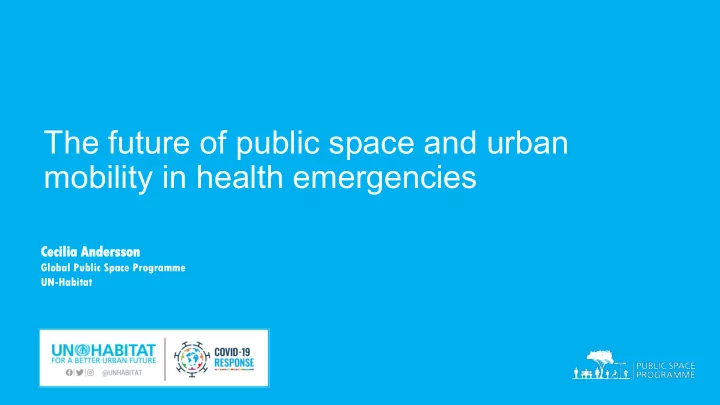

The future of public space and urban mobility in health emergencies Cecil cilia ia Ander ersson son Global Public Space Programme UN-Habitat
. . CURRENT SITUATION CITIES AND COVID-19 Majority of coronavirus cases worldwide are found in about 1,500 cities About 1.8 billion people (20%) of the world's population, lack adequate housing Lack of access to outside spaces can have a detrimental effect on residents' mental and physical health. Public transportation ridership has reduced by about 80% in some cities. Fear of spread of COVID-19 due to large numbers of people confined in a small space with limited ventilation Disruption of social and protection networks and decreased access to basic services exacerbate the risk of violence for women and children Reduced livelihood (urban poor), job insecurity
GLOBAL AGENDA’S, CITIES AND COVID-19 SUSTAINABLE DEVELOPMENT Goal 3: Ensure healthy lives and promote well-being for all at all ages Goal 11: Make cities and human settlements inclusive, safe, resilient and sustainable Target 11.2: “By 2030, provide access to safe, affordable, accessible and sustainable transport systems for all, improving road safety, notably by expanding public transport, with special attention to the needs of those in vulnerable situations, women, children, persons with disabilities and older persons” T a rget 11.7 “By 2030, provide universal access to safe, inclusive and accessible green spaces and public spaces, particularly for women and children, the elderly and people with disabilities”
UN-HABITAT COVID-19 RESPONSE PLAN UN-Habitat launched the COVID-19 Response Plan for 64 countries (17 in Asia and Pacific) that focuses on immediate action in poor and densely populated areas. It focuses on promoting an integrated approach in 3 major response areas: 1. Support local government and community driven solutions in poor and vulnerable neighborhoods; 2. Provide urban data, mapping and knowledge for informed decision-making; 3. Mitigate the economic impact and initiate recovery.
: THE FUTURE OF PUBLIC TRANSPORT & MOBILITY AFTER THE PANDEMIC PUBLIC LIC TRASN SNPO PORT RT & MOBILIT BILITY Y REMAIN AINS S AN ESSENTIAL ENTIAL SERVICE VICE 1. Government needs to co-ordinate with public transport operators (both formal and informal) to ensure high standards of cleanliness and physical distancing. 2. Government needs to ensure the protection of public transit workers – cashless payments, prohibit front door boarding 3. Government needs to reduce overcrowding in public transport – limit # of riders, staggering working hours 4. Cycling and walking can be promoted as an alternative. 5. Underuse of public transport vehicles – new ideas can be tried e.g. on demand transit service or delivery of goods and supplies. 6. Opportunity to start planning the sustainable mobility of tomorrow ….! 7. 15-minute city (Paris)
THE TWO FACES OF PUBLIC SPACES CITIES AND COVID-19 Public space has become vital for cities and their residents. It has proven to be a Public space considered critical infrastructure to reduce risk, a basic urban service, an infrastructure of a threat to health opportunities and a critical place for the well-being of citizens, especially in times of crisis.
: THE FUTURE OF PUBLIC SPACE AFTER THE PANDEMIC BUILD LDING ING BACK K TRUST ST IN PUBLIC IC SPACE CE 1. Carry out an inventory of public spaces throughout the city. 2. Well-connected and integrated system of public spaces including streets 3. Expand the amount of land allocated to public space including streets 4. Flexible public space (programming and design) 5. Equitable distribution of public spaces across the city and at the neighbourhood scale. 6. Plan for the self-sufficient neighbourhood or “15 -minute compact city neighbourhood ” 7. Public space and public facilities can provide essential services required for marginalized communities 8. Public space can be a platform for sharing (connecting places and people) 9. For many, especially the poor, public space is important for their livelihoods
Final thoughts • Paradigm shift on city building, a fluid collaboration that brings together the scientific community, the community of practice of the built environment and policy makers; • Documentation and Learning and Exchanging , need to continue documenting, researching and learning from community innovations; • Systemic change doesn’t happen without supportive policy - a political agenda that places health at the center of urban development, ensuring that no one and no place is left behind; • Committed governments and communities , in an urban agenda that is inclusive and aims at the well-being of all; • Promote an integrated response : leveraging experience, expertise and partnerships to deliver solutions • Public Space Journal- Special Issue: 2020 a year without public space.
Thank You! Cecilia ia Ande derss sson on Global Public Space Programme
Recommend
More recommend